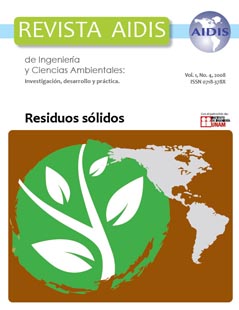Evaporation of leachate produced in a landfill in Rio de Janeiro as an alternative treatment technology
Main Article Content
Abstract
The selection of the appropriate technology for leachate treatment should be based on a careful evaluation of technical and economic parameters, since these wastes present high pollutant loads. Evaporation is a technological treatment option because it allows a reduction in the leachate volume of up to 70% and uses the gas generated in the landfill as an energy source, and therefore can qualify these facilities to obtain carbon credits. However, this treatment process generates two types of wastes (viscous and gaseous) whose composition requires in-depth studies. Companhia Municipal de Limpeza Urbana (COMLURB), the company that manages the solid wastes in the State of Rio de Janeiro, Brazil, developed an evaporation equipment called Unit Evaporator (EU).This equipment operates with a continuous feeding of leachate and can be installed near biogas collection wells in sanitary landfills. In this context, this work has the purpose of evaluating the evaporation of leachate through the EU and the characteristics of the wastes generated. The study was developed in two distinct phases: (1) conduction of evaporation bench-scale tests; (2) Operation of the EU prototype installed in Gramacho sanitary landfill. The following results are noteworthy: (a) the raw leachate from Gramacho landfill presented a significant variation of physicochemical characteristics and low ratio BOD/COD (0.12), making its treatment difficult by biological processes; (b) the GEM 2000 equipment determined that the biogas quality was consistent with the values typically found in literature. The biogas used as energy source by the EU was made up of 56.6% of CH4, 40% of O2, and 3.4% of other substances; (c) EU output, monitored in the field reached an average of 27.4 L/h. The decrease in the EU performance at the end of an operational period was considered an indication of the need for internal cleaning; (d) the viscous waste generated at evaporation in the bench test was characterized by the increase in pH (10.0) and build-up of organic matter (9,493 mg DQO/L). Condensed fumes presented high values of ammonia (3.481 mg NH4/L) and pH (9,0), and low concentrations of solids and organic matter; (e) wastes generated in the EU presented the following characteristics: high pH and COD values in the waste 1 (viscous), low ammonia concentration in the condensate because of the difficulty to contain this contaminant in the sample due to field environmental conditions. Waste 2 (solid) was characterized by a high COD and ammonia concentrations, significant decrease in pH, specific weight of 973.4 kg/m³ and a ratio of 1.94 m³ of evaporated leachate for an output of 1 kg of this waste.
